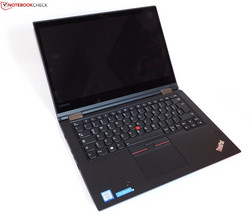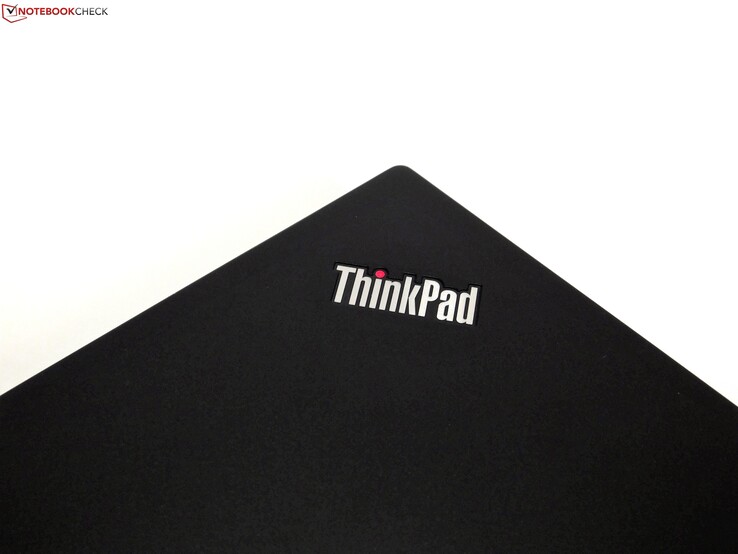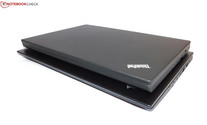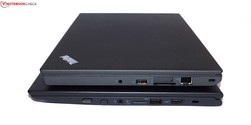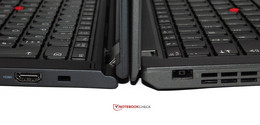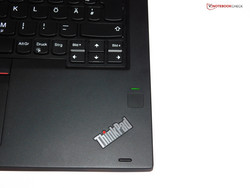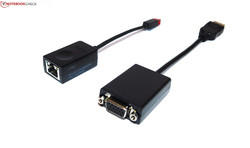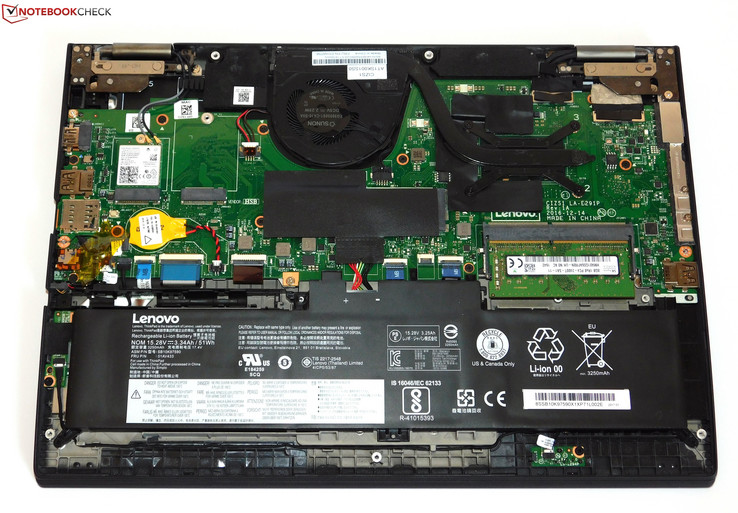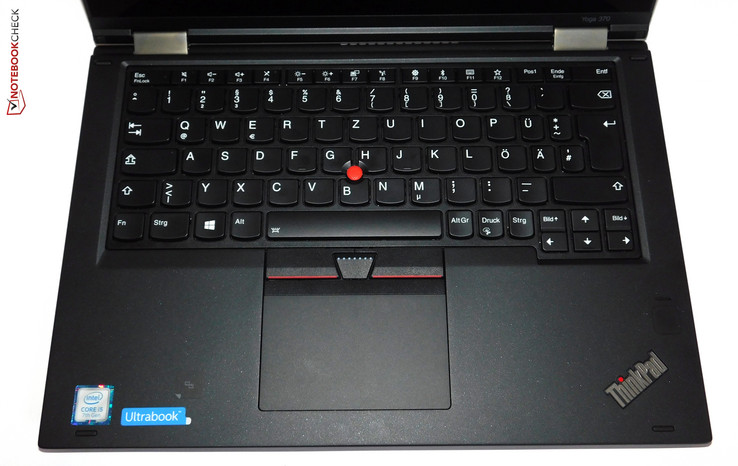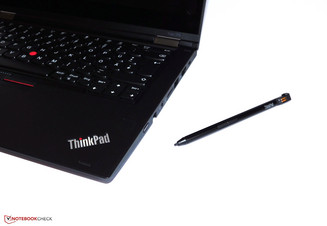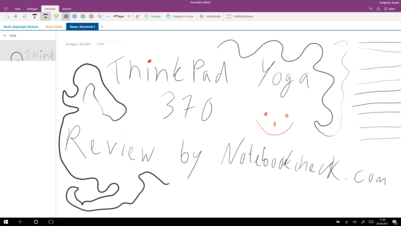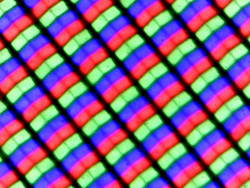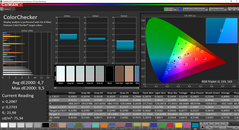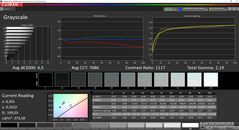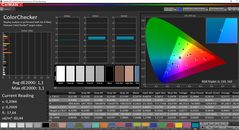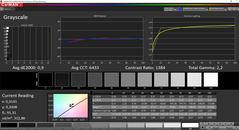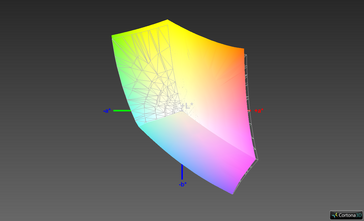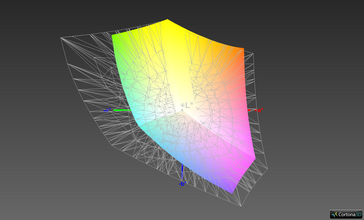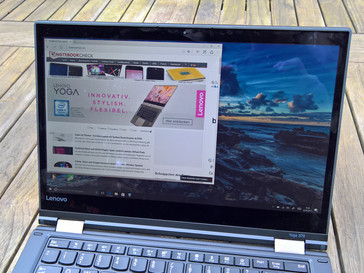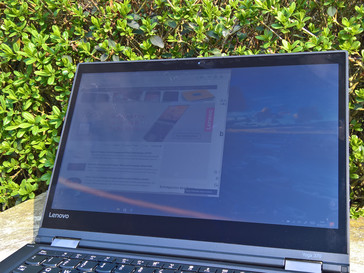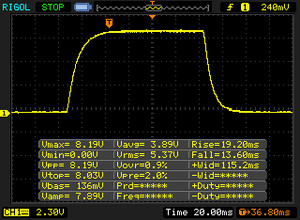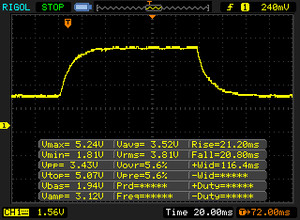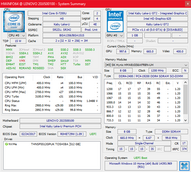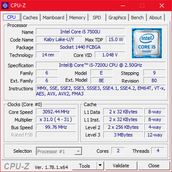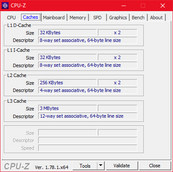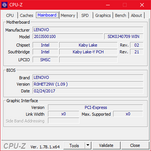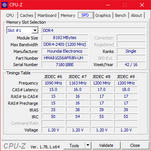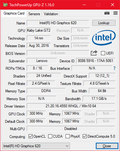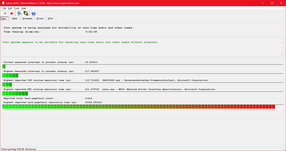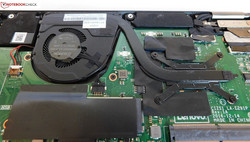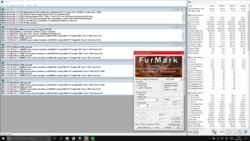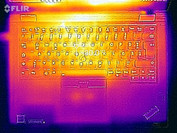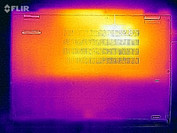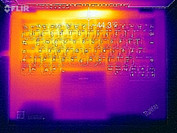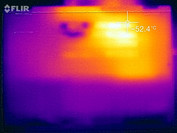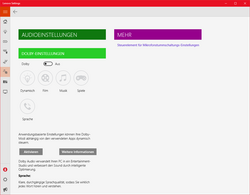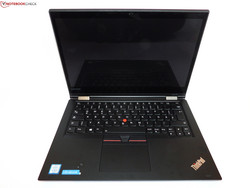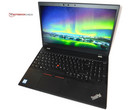Lenovo ThinkPad Yoga 370 (7200U, FHD) Convertible Review

For the original German review, see here.
The most famous of the world’s largest computer manufacturer’s brand names - besides the Moto brand acquired during the Motorola takeover - are Yoga and ThinkPad. While the former had been used exclusively for consumer-branded products the latter had been the business market top dog for many years. Until 2013, that is, when Lenovo first created the ThinkPad Yoga and brought these two together. The first model, a 12-inch convertible based on Intel’s Haswell processors, was followed by the ThinkPad Yoga 14 and ThinkPad Yoga 15 a year later. In 2016, Lenovo discontinued the latter again and three new models were introduced: the ThinkPad Yoga 260, the ThinkPad Yoga 460, and the much more expensive ThinkPad X1 Yoga.
With its 2017 Kaby Lake generation Lenovo has once more revised the Yoga line-up from scratch. Based on customer feedback, according to which customers found the Yoga 260’s 12.5-inch display too small and the Yoga 460 too large, Lenovo did the only sensible thing: they scrapped both Yoga models and replaced them with a single ThinkPad Yoga device alongside their X1 Yoga: the 13.3-inch ThinkPad Yoga 370. Its mission remained unaffected: to attract business customers and students alike for whom the X1 Yoga is too expensive. Our review unit is part of Lenovo’s campus program line-up for students, teachers, university employees, and apprentices, which is why despite the Core i5 CPU and a 512 GB SSD its price tag of 1338 Euros (~$1432) is still comparatively low. A similar model for non-campus customers, which includes an LTE modem as well, is going to set you back 1639 Euros (~$1754).
Being its only direct competitor, the HP EliteBook x360 practically forces itself upon us for the sake of this comparison, and in addition we’ve also chosen Dell's XPS 13 2-in-1, a competitor from the consumer side of the market, and the X1 Carbon (2017), the X1 Yoga (2016), and the Yoga 370’s direct predecessor, the ThinkPad Yoga 260.
Case
If you’re having an acute case of déjà vu when first encountering the Yoga 370 you’re neither crazy nor mistaken. Lenovo’s recipe for solving the above-mentioned issues with the previous year’s line-up (Yoga 260: display too small; Yoga 460: too large) was rather simple: with its tapered design the almost entirely black case (also available in silver) is almost 100% identical to last year’s Yoga 260 with only a few minor modifications. Basically, Lenovo put a 13.3-inch display into a 12.5-inch chassis.
As is the case with all of its ThinkPads Lenovo uses a mix of materials for the case. The bottom shell and the lid are made of carbon while the palm rest is made of aluminum. Given its convertible nature the display is covered by glass. All surfaces are coated so you cannot tell which part is made of what material based on touch and feel. The base and palm rest have a slight rubbery feel to them, the display is more velvety and slick, and in its entirety the feel of the device is very high-quality. The case’s stability benefits from its high-tech materials as well, and we found only minimal traces of bending or flexing on both the display and the base. Applying pressure to the display’s back side has absolutely no visible effect on the display whatsoever.
Unfortunately, the breaking point we found in last year’s Yoga 260 is still around: the digitizer slot on the right-hand side. Its position has remained unchanged and only time will tell whether or not it is going to be as problematic in the Yoga 370 as it was in the Yoga 260. In theory it’s feasible that the moderate alterations to the case - it is slightly wider compared to the Yoga 260 - have solved this problem once and for all. We did notice a quiet clicking noise when opening the lid, something we would not have expected from a notebook as expensive as this. Aside from that the Yoga 370 is perfectly built, and there are neither sharp nor noticeable edges.
As with any 360-degree convertible the hinges are very important, and Lenovo has equipped the Yoga 370 with two hinges covered with silver metal caps. There is some bouncing back, for example in wobbly environments or when tapping on the device’s touchscreen in laptop mode. The hinges from Lenovo’s own Yoga 910 consumer flagship are much sturdier and better in this regard. The lid cannot be opened one-handed.
Thanks to its thinner chassis the Yoga 370 feels much more modern when compared to the ThinkPad X270. In addition, it also feels much more premium and looks better, although beauty obviously is in the eye of the beholder. All-in-all, its design is much closer to the X1 Carbon instead of the overall more compact yet thicker classical X series.
Dell's XPS 13 2-in-1 is by far the smallest notebook in our test group, thanks to the very thin bezels around its 13.3-inch display. The Yoga 370’s direct competitor, the HP EliteBook x360, is practically the same size, which is also true for the X1 Carbon despite its 14-inch display. Its convertible version, the X1 Yoga, is significantly larger. The largest and at 1.8 kg / 4 lbs heaviest device is the ThinkPad Yoga 460; all other laptops weigh in at between 1.1 kg / 2.4 lbs and 1.4 kg / 3 lbs.
Connectivity
Like the X1 Carbon, the Yoga 370 is also leaving the proprietary Onelink+ port behind in favor of Thunderbolt 3. Aside from Ethernet the new port replaces all other capabilities previously implemented through the Onelink+ port - charging, docking, and DisplayPort. Native Ethernet is still available through the Yoga 370’s Mini RJ45 port, which we have already encountered in the X1 Carbon. Compared to the Yoga 260, the Mini DisplayPort is missing.
In addition to the Thunderbolt 3 port the Yoga 370 is also still equipped with Lenovo’s proprietary slim tip charging connector, thereby making our review unit much more versatile than the X1 Carbon: if you already own a number of slim tip chargers you can simply continue using these instead while still enjoying the benefits of a USB-C charger that can be used for charging both your smartphone and your laptop, while you’re out and about.
Port placement is sophisticated. The ports are more or less split up between the left and right sides and tend to be located towards the rear of the device. Apart from the Mini RJ45 and the Thunderbolt 3 port there are no spacing issues, but we would have preferred if the Thunderbolt 3 port would have been placed further back. Even so, it is by far not as bad as the ThinkPad T470s.
SD-Card Reader
Like the Yoga 260 before it the Yoga 370 also features a Micro SD-card reader on its right side. This is much preferred to the placement on the X1 Carbon but removing cards from the reader can still be rather finicky.
In our benchmarks, for which we have used the same Toshiba Exceria Pro M401 reference card that we use for our smartphone reviews, our review unit did about as well as its more expensive X1 cousin, and therefore also about as well as the Dell XPS 13 2-in-1. In other words: its performance was only average.
| SD Card Reader | |
| average JPG Copy Test (av. of 3 runs) | |
| Lenovo ThinkPad Yoga 370-20JJS00100 | |
| Dell XPS 13-9365 2-in-1 | |
| Lenovo ThinkPad X1 Carbon 2017-20HQS03P00 | |
| maximum AS SSD Seq Read Test (1GB) | |
| Dell XPS 13-9365 2-in-1 | |
| Lenovo ThinkPad Yoga 370-20JJS00100 | |
| Lenovo ThinkPad X1 Carbon 2017-20HQS03P00 | |
Communication
All Kaby Lake models in our test group were equipped with Intel’s 2x2 AC 8265 Wi-Fi card. Both ThinkPads performed equally fast and delivered the best Wi-Fi performance of all the contestants with Dell and HP trailing behind. In everyday use the Wi-Fi card in our review unit behaved inconspicuously and without any disruptions.
In addition to Wi-Fi the Yoga 370 also supports Bluetooth 4.2, Gigabit Ethernet (via aforementioned Mini RJ45 port), and, as indicated by the sticker on the palm rest, NFC. A WWAN card was not included, and there were no preinstalled antennas either.
The webcam and both microphones, placed above the display, performed well. Image quality was noisy and its colors were distorted. Audio quality was rather quiet and muffled.
Security
As with all of its business brethren one of the Yoga 370’s focal points is security. The Kensington lock is accompanied by a fingerprint reader and an optional smartcard reader, which our review unit was not equipped with. The fingerprint reader is a touch reader, which makes it very fast and precise.
The UEFI setup supports further security features, such as TPM 2.0, Computrace Anti-Theft, and BIOS passwords. In addition, a sensor can detect whether or not the bottom case had been opened, and a supervisor password can be requested in these cases.
Accessories
Unlike other ThinkPads, the Yoga 370 comes with several noteworthy accessories in addition to the slim tip charger. As with the X1 Carbon, included in delivery are also two adapters: an HDMI-to-VGA adapter and a Mini RJ45-to-RJ45 adapter. The latter is only fair given that the Mini RJ45 port on the laptop would be rendered pointless without it.
Optional accessories include various docking options. Given its universal nature in theory every USB-C or Thunderbolt 3 dock can be used with the Yoga 370, and Lenovo offers two different compatible docks itself: the USB-C dock (model 40A90090EU), which is already available, and the Thunderbolt 3 dock (model 40AC0135EU) which, at the time of writing, wasn’t.
Maintenance
Generally speaking, the Yoga 370 is one of the more accessible laptops thanks to the construction of its base. There are only a few latches at the front holding the bottom panel in place, unlike for example the ThinkPad X270, which has these all around the base unit. Undoing the nine screws opens a tiny gap at the front that can be used for undoing the front latches without damaging the unit or the cover itself.
With the bottom cover removed you have access to almost all of its hardware, including the fan. Upgradability is better than on the X1 Carbon with its very similar design, because our Yoga 370 unit did not have its single memory module soldered onto the motherboard. This brings us to a rather peculiar design decision on Lenovo’s part: all WWAN-equipped models have exactly 8 GB of RAM soldered onto the motherboard. In return, all models with a single DDR4 RAM slot, such as our review unit, lack the antennas necessary to install a WWAN card.
Lenovo’s Yoga 370 Hardware Maintenance Manual is, as always, a huge help no matter what you plan to upgrade or disassemble.
Warranty
By default, the Yoga 370’s warranty is only a penny-pinching 12 months bring-in, compared to the standard 36-month on-site warranty for all T- and X- models. This is available as an optional upgrade, and the warranty can be extended to up to five years on-site and expanded to include accident prevention as well. Please see our Guarantees, Return Policies and Warranties FAQ for country-specific information.
Input Devices
Keyboard
Lenovo’s decision to base the Yoga 370 on the Yoga 260’s 12.5-inch design has both pros and cons. One of the cons is certainly the non-standard sized keyboard the engineers had to use, similar to the ThinkPad X270. As a result thereof some keys are smaller than usual and require some getting used to.
The keyboard’s general touch and feel were nothing short of what we came to expect from a ThinkPad. A very nice actuation point combined with a generous, albeit slightly shorter than on older ThinkPads, key travel. Prolific writers will love the smoothness of the keycaps. The only improvement to this keyboard would be if it was full size, like the X1 Carbon's and X1 Yoga's keyboards, respectively.
A two-stage blue-and-white keyboard backlight is standard on all Yoga 370 models. It can be activated and cycled through via FN + Space. Additionally, the Yoga 370 also features an ambient light sensor hidden very well in the top right corner of its display bezels, and therefore optionally supports automatic keyboard backlight regulation.
One extra feature, exclusive to the ThinkPad Yoga series, is the notebook’s so-called “lift and lock” keyboard mechanism. In tablet mode the entire keyboard frame between the keys is lifted up, producing a flat and even surface and effectively locking the keys in place. Not only does this increase the comfort of using the device in tablet mode but it also protects the keys from accidental damage.
Touchpad/Touchscreen
The keyboard is not the only input device taken straight out of the X270; the same can be said for the similarly sized and therefore comparatively small touchpad. Its surface is a bit smoother and slippage has been improved over the X270, and the integrated clicking mechanism of the ClickPad produces full and audible clicks. As with all other current ThinkPads the touchpad is based on Microsoft’s precision touchpad specification. Thus, the implementation of multitouch gestures and its precision are near perfect.
The red TrackPoint is located between the B-G-H keys, and it worked as accurate and well as expected. In addition to the touchpad it therefore offers another way of controlling the mouse pointer.
Given that it’s a convertible, the Yoga 370 features yet two more input devices: a touchscreen and a digitizer. The 10-point touchscreen worked flawlessly, and so did the Wacom AES digitizer. It is capable of detecting 2,048 different levels of pressure, offers two rather flat and unobtrusive buttons, and it is charged while inserted into the digitizer slot. It lacks an eraser, but one of the buttons is preconfigured to act as such. The digitizer worked very well and accurately, and the Yoga 370 did not suffer from the same issues many older tablets suffer from, namely sensitivity and detection issues along the edges of the screen. Palm detection worked as expected as well, and we had no trouble comfortably resting our palm on the screen while using the digitizer to draw or write on the screen.
Display
Yoga 370 customers don’t really have a choice in regards to the display: the only one available is a 13.3-inch 16:9 1920x1080 Full HD LED IPS panel. Our review unit came equipped with a panel made by Sharp, model number LQ133M1JX15, but we don’t know whether or not Lenovo uses other panels as well. Either way, the display is always glossy, and the semi-matte option we remember from older ThinkPad Yoga models has been eliminated.
Lenovo’s official brightness rating for the Yoga 370’s display is 300 nits. Both the ThinkPad X270 and the ThinkPad X1 Carbon were rated similarly yet failed to achieve their rated brightness in our tests. The Yoga 370 on the other hand exceeded its rating by a significant margin, and with its average brightness of 356 nits it’s brighter than all of its competitors. Its closest competitor, the HP EliteBook x360, is exactly 100 nits darker. Its brightness distribution of 87% is adequate, and we found no noticeable backlight-bleeding. Unfortunately, at brightness levels below 50% the display did show PWM-flickering at a very low 217 hertz.
Screen Flickering / PWM (Pulse-Width Modulation)
| Screen flickering / PWM detected | 217.4 Hz | ≤ 50 % brightness setting | |
The display backlight flickers at 217.4 Hz (worst case, e.g., utilizing PWM) Flickering detected at a brightness setting of 50 % and below. There should be no flickering or PWM above this brightness setting. The frequency of 217.4 Hz is relatively low, so sensitive users will likely notice flickering and experience eyestrain at the stated brightness setting and below. In comparison: 53 % of all tested devices do not use PWM to dim the display. If PWM was detected, an average of 8108 (minimum: 5 - maximum: 343500) Hz was measured. | |||
| |||||||||||||||||||||||||
Brightness Distribution: 87 %
Center on Battery: 373 cd/m²
Contrast: 1133:1 (Black: 0.33 cd/m²)
ΔE ColorChecker Calman: 4.7 | ∀{0.5-29.43 Ø4.78}
ΔE Greyscale Calman: 6.5 | ∀{0.09-98 Ø5}
97.2% sRGB (Argyll 1.6.3 3D)
63.1% AdobeRGB 1998 (Argyll 1.6.3 3D)
69.9% AdobeRGB 1998 (Argyll 3D)
97.3% sRGB (Argyll 3D)
67.9% Display P3 (Argyll 3D)
Gamma: 2.19
CCT: 7086 K
| Lenovo ThinkPad Yoga 370-20JJS00100 Sharp LQ133M1JX15, , 1920x1080, 13.3" | Lenovo ThinkPad Yoga 260 20FD001XGE LEN40E6 N125HCE-GN1, , 1920x1080, 12.5" | Lenovo Thinkpad X1 Yoga 20FQ-000QUS VVX14T058J10, , 2560x1440, 14" | Lenovo ThinkPad X1 Carbon 2017-20HQS03P00 B140HAN03_1, , 1920x1080, 14" | HP EliteBook x360 1030 G2 CMN1374, , 1920x1080, 13.3" | Dell XPS 13-9365 2-in-1 1920x1080, 13.3" | |
|---|---|---|---|---|---|---|
| Display | -36% | 0% | -11% | -7% | -29% | |
| Display P3 Coverage (%) | 67.9 | 42.98 -37% | 68.1 0% | 61.4 -10% | 65.5 -4% | 47.32 -30% |
| sRGB Coverage (%) | 97.3 | 62.8 -35% | 97.2 0% | 85.9 -12% | 88.8 -9% | 71.1 -27% |
| AdobeRGB 1998 Coverage (%) | 69.9 | 44.55 -36% | 70.2 0% | 62.4 -11% | 64.9 -7% | 48.83 -30% |
| Response Times | -22% | 9% | 3% | -7% | -7% | |
| Response Time Grey 50% / Grey 80% * (ms) | 42 ? | 64 ? -52% | 38 ? 10% | 41.6 ? 1% | 55.2 ? -31% | 48 ? -14% |
| Response Time Black / White * (ms) | 32.8 ? | 30 ? 9% | 30.4 ? 7% | 31.6 ? 4% | 27.2 ? 17% | 32.8 ? -0% |
| PWM Frequency (Hz) | 217.4 ? | 219 ? | 1042 ? | |||
| Screen | -29% | -13% | -3% | -7% | -9% | |
| Brightness middle (cd/m²) | 374 | 371 -1% | 284.7 -24% | 311 -17% | 262 -30% | 322.6 -14% |
| Brightness (cd/m²) | 356 | 335 -6% | 272 -24% | 288 -19% | 256 -28% | 306 -14% |
| Brightness Distribution (%) | 87 | 84 -3% | 89 2% | 85 -2% | 83 -5% | 91 5% |
| Black Level * (cd/m²) | 0.33 | 0.29 12% | 0.383 -16% | 0.24 27% | 0.25 24% | 0.19 42% |
| Contrast (:1) | 1133 | 1279 13% | 743 -34% | 1296 14% | 1048 -8% | 1698 50% |
| Colorchecker dE 2000 * | 4.7 | 8.51 -81% | 5.24 -11% | 5.5 -17% | 5.13 -9% | 7.7 -64% |
| Colorchecker dE 2000 max. * | 9.5 | 20.43 -115% | 11.22 -18% | 9 5% | 9.46 -0% | 11.1 -17% |
| Greyscale dE 2000 * | 6.5 | 9.23 -42% | 7.32 -13% | 6.2 5% | 6.23 4% | 7.9 -22% |
| Gamma | 2.19 100% | 2.24 98% | 2.22 99% | 2.02 109% | 2.45 90% | 2.88 76% |
| CCT | 7086 92% | 6759 96% | 6277 104% | 5950 109% | 6413 101% | 7044 92% |
| Color Space (Percent of AdobeRGB 1998) (%) | 63.1 | 41 -35% | 70.17 11% | 55.96 -11% | 57.84 -8% | 44.1 -30% |
| Color Space (Percent of sRGB) (%) | 97.2 | 62 -36% | 94.68 -3% | 85.77 -12% | 88.57 -9% | 69.9 -28% |
| Total Average (Program / Settings) | -29% /
-30% | -1% /
-8% | -4% /
-4% | -7% /
-7% | -15% /
-13% |
* ... smaller is better
A contrast ratio of 1133:1 and a black level of 0.33 nits were right where we would expect them to be for a good IPS panel. Out-of-the-box, the display did have a slight green tint, a phenomenon encountered quite regularly with IPS displays that have not yet been calibrated. As usual, this can be addressed with the ICC profile available for download in the box above.
sRGB coverage was a very good 97% and once again best of its class. The display is therefore suitable for semi-professional photo editing. Colors in general seemed very natural. All things considered we liked the display with its sharp and crisp image quality and its lively colors a lot.
Usually, glossy displays and outdoor usage don’t really go hand in hand. However, thanks to its high brightness the Yoga 370 can be used outdoors despite its glossy surface, at least in the shade. Direct sunlight would require a much brighter display with at least 400 or even 500 nits. Since the black chassis heats up significantly when exposed to direct sunlight we would recommend finding a shady place instead.
Display Response Times
| ↔ Response Time Black to White | ||
|---|---|---|
| 32.8 ms ... rise ↗ and fall ↘ combined | ↗ 19.2 ms rise | |
| ↘ 13.6 ms fall | ||
| The screen shows slow response rates in our tests and will be unsatisfactory for gamers. In comparison, all tested devices range from 0.1 (minimum) to 240 (maximum) ms. » 88 % of all devices are better. This means that the measured response time is worse than the average of all tested devices (20.2 ms). | ||
| ↔ Response Time 50% Grey to 80% Grey | ||
| 42 ms ... rise ↗ and fall ↘ combined | ↗ 21.2 ms rise | |
| ↘ 20.8 ms fall | ||
| The screen shows slow response rates in our tests and will be unsatisfactory for gamers. In comparison, all tested devices range from 0.165 (minimum) to 636 (maximum) ms. » 66 % of all devices are better. This means that the measured response time is worse than the average of all tested devices (31.6 ms). | ||
Viewing angles were very good: the IPS panel only got moderately darker with increased angles. Other than that image quality didn't suffer. Due to its glossy surface extreme viewing angles might be rendered beyond recognition in bright environments.
External displays can be connected via HDMI or Thunderbolt 3. Both ports provided a sharp and crisp image.
Performance
Seven different models are available for purchase in Germany as we speak, two of which - our review unit included - are special editions exclusively available through Lenovo’s campus program. The other models are available either at full price or at a reduced price through the campus program as well. The Yoga 370’s price range extends from 1369 Euros (~$1465) to 1788 Euros (~$1914). It is slightly cheaper than the HP EliteBook x360 (1628 - 2336 Euros, ~$1727 - ~$2478) and considerably cheaper than last year’s X1 Yoga (1979 - 3268 Euros, ~$2099 - ~$3467). The XPS 13 2-in-1 is similarly priced, at 1399 - 1899 Euros (~$1484 - ~$2014).
The most significant difference between the various models is the CPU, which can be either a Core i5-7200U or a Core i7-7500U. Then there are two different SSDs available, a 256 and a 512 GB model. In terms of RAM we have aforementioned differentiation between models with and without an LTE modem. The latter will always have 8 GB of DDR4-2133 RAM soldered onto their motherboard, the former - like our review unit - are available with either 8 or 16 GB of RAM, which can be upgraded thanks to the single SODIMM slot.
Another point of differentiation is the color. Six of the seven models are black, one is silver. Then there’s the operating system: regular models come with Windows 10 Professional preinstalled, Campus models come with either the cheaper Windows 10 Home instead or no Windows license at all.
Processor
One of the processors used most often in modern laptops is Intel’s Core i5-7200U, which our review unit was equipped with as well. This dual-core 15 W Intel U-series CPU was specifically designed with Ultrabooks in mind. All of our contestants are based on these U-series CPUs, except for the Dell XPS 13 2-in-1, which is based on the even more energy-efficient Y-series designed for ultra-thin tablets and Ultrabooks. An overview of various CPUs can be found in our CPU benchmark list.
The i5-7200U with its 2.5 GHz base clock speed is capable of a turbo boost of up to 3.1 GHz. Running the Cinebench multi-core benchmark, the CPU failed to achieve its full turbo speed and ran at 2.9 GHz instead. The reason for this is not a thermal but a TDP limit instead. Even during our 30-minute long Cinebench multi-core loop benchmark the CPU never achieved its full turbo potential and maximum performance, at which the system should have scored around 330 points. Close to the end of this test performance even fell noticeably, and our prime suspect is some background task instead of additional performance limitations by Lenovo.
Due to its restricted turbo potential the Yoga 370 did not score too well when compared to its competitors. In single-core runs it scored even worse than its own predecessor, and while it managed to score slightly better than laptops equipped with Intel’s Skylake it was far behind the HP EliteBook x360 (+11%) and the ThinkPad X1 Carbon (+15%). While both of these were equipped with faster CPUs we would have expected the Yoga 370 to close the gap had it been running at full turbo speed.
Performance on battery was not reduced.
System Performance
The PCMark results pretty much reflected our Cinebench results. The Yoga 370’s score was mediocre in one test, and it came in second to last in the other. We blame the Yoga’s single-channel memory configuration and, once again, its limited CPU performance. In everyday use these should not be noticeable, and thanks to its SSD the system feels smooth and snappy.
| PCMark 8 Home Score Accelerated v2 | 3539 points | |
| PCMark 8 Creative Score Accelerated v2 | 4504 points | |
| PCMark 8 Work Score Accelerated v2 | 4314 points | |
Help | ||
Storage Devices
Our review unit came equipped with the exact same SSD as the ThinkPad X270, a 512 GB Toshiba NVMe PCIe SSD, model number THNSF5512GPUK. Since the Yoga 370 is incapable of housing 2.5-inch drives the SSD is an M.2 2280 model.
Our AS SSD and CrystalDiskMark benchmarks exposed this NVMe SSD to be mediocre at best. The X1 Carbon's Samsung PM961 was significantly faster, although it is also significantly more expensive. It did manage to beat SSDs with a SATA III interface, for example the approximately 35% slower SanDisk SSD the EliteBook x360 was equipped with. We would like to add though that the differences in CrystalDiskMark’s meaningful 4k read test were almost insignificant. Only the X1 Carbon managed to distance itself from its competitors in this test.
Additional benchmark results and comparisons with current and older SSDs and hard drives can be found in our SSD-/HDD benchmark tool.
| Lenovo ThinkPad Yoga 370-20JJS00100 Toshiba NVMe THNSF5512GPUK | Lenovo ThinkPad Yoga 260 20FD001XGE Samsung SSD PM871 MZNLN256HCHP | Lenovo Thinkpad X1 Yoga 20FQ-000QUS Samsung SSD PM871 MZNLN512HCJH | Lenovo ThinkPad X1 Carbon 2017-20HQS03P00 Samsung PM961 NVMe MZVLW512HMJP | HP EliteBook x360 1030 G2 Sandisk SD8TN8U-256G-1006 | Dell XPS 13-9365 2-in-1 Toshiba NVMe THNSN5256GPUK | |
|---|---|---|---|---|---|---|
| CrystalDiskMark 3.0 | -35% | -30% | 74% | -35% | 3% | |
| Read Seq (MB/s) | 1070 | 468.9 -56% | 512 -52% | 1827 71% | 467.1 -56% | 1206 13% |
| Write Seq (MB/s) | 484.5 | 297.3 -39% | 443.8 -8% | 1383 185% | 443.6 -8% | 629 30% |
| Read 512 (MB/s) | 680 | 397.9 -41% | 363.1 -47% | 814 20% | 312.3 -54% | 966 42% |
| Write 512 (MB/s) | 483.1 | 297.1 -39% | 377.8 -22% | 1098 127% | 372.5 -23% | 410.7 -15% |
| Read 4k (MB/s) | 30.55 | 33.11 8% | 33.99 11% | 61 100% | 29.43 -4% | 32.93 8% |
| Write 4k (MB/s) | 127.3 | 85.1 -33% | 81.9 -36% | 172.2 35% | 56.5 -56% | 121.2 -5% |
| Read 4k QD32 (MB/s) | 460.8 | 398.3 -14% | 327.4 -29% | 601 30% | 311.3 -32% | 411 -11% |
| Write 4k QD32 (MB/s) | 414.5 | 136.6 -67% | 189.2 -54% | 495.6 20% | 225.2 -46% | 250.2 -40% |
Graphics Card
Without further ado, we present to you the often-tested Intel HD Graphics 620. It does not have any dedicated memory at its disposal, and its 24 execution units have to access shared memory instead.
This limits the Yoga 370’s graphics performance somewhat since, as we have already explained above, the Yoga 370 is only equipped with a single RAM slot on its motherboard. The GPU is therefore limited to single-channel memory speeds resulting in a noticeably reduced graphics performance. The WWAN-equipped models with 8GB of RAM soldered onto the motherboard will most likely be running in a dual-channel configuration, which on the one hand would improve graphics performance but on the other would limit you to only 8 GB of RAM without any way of upgrading that down the road. Unfortunately, there is no way to combine 16 GB of RAM with an LTE modem in the Yoga 370.
At first, we noticed a conspicuously low graphics performance. After some research we were able to locate the culprit in the device’s BIOS setup - it came preconfigured with 256 MB of “Total Graphics Memory”, and changing that to 512 MB improved graphics performance in some benchmarks noticeably. For example, it scored a low 873 points in 3DMark 11 prior to the adjustment and a decent and expected 1,337 points afterwards.
Generally speaking, the ThinkPad Yoga 370 scored rather poorly in terms of graphics performance, and it even fell behind the Dell XPS 13 2-in-1's Intel HD Graphics 615. Only its own predecessor was even slower than that. At least full graphics performance is available when running on battery.
Additional GPU comparisons can be found in our GPU benchmark list.
| 3DMark 11 Performance | 1439 points | |
| 3DMark Ice Storm Standard Score | 51316 points | |
| 3DMark Cloud Gate Standard Score | 5704 points | |
| 3DMark Fire Strike Score | 773 points | |
Help | ||
Gaming Performance
Given the poor performance in our graphics benchmarks it is no surprise that the Yoga 370 is not the most suitable laptop for gaming. Of all games tested only the several years old BioShock Infinite was even playable on low details. Thus, the usual HD 620 motto applies in this case as well: older games with reduced details yes, current games no. Not even Civilization VI was playable.
At this point, we should mention that the Yoga 370’s other predecessor, the ThinkPad Yoga 460, was available with an optional Nvidia GeForce 940MX graphics card. The Yoga 370 does not have this option, which means it has been completely eliminated without replacement. Users interested in the Yoga 460 due to its graphics performance will certainly and rightly be disappointed.
| low | med. | high | ultra | |
|---|---|---|---|---|
| BioShock Infinite (2013) | 37.6 | 23.96 | ||
| Company of Heroes 2 (2013) | 18.6 | |||
| The Witcher 3 (2015) | 12.6 | |||
| Rise of the Tomb Raider (2016) | 16.4 | |||
| Civilization 6 (2016) | 24.8 | 9.6 |
Emissions
System Noise
When idle the fan is off, which is normal and expected for notebooks equipped with a 15 W TDP processor. During normal office use the fan does rear its head regularly. Thus, a completely inaudible operation was not possible with the Yoga 370. Under load, the fan was very noticeable and louder than the EliteBook x360’s, although the difference was negligible. Compared to the X270 the Yoga 370’s fan was significantly quieter and, much more importantly, not as whiny. Which means that while it does not score perfectly in this category the fan wasn't problematic at all.
We were unable to locate any other noises such as coil whining during our tests. Due to the fact that the Yoga 370 is incapable of housing 2.5-inch hard drives this can also be eliminated as a noise source.
Noise level
| Idle |
| 28.6 / 28.6 / 31.2 dB(A) |
| Load |
| 33.7 / 36.7 dB(A) |
 | ||
30 dB silent 40 dB(A) audible 50 dB(A) loud |
||
min: | ||
Temperature
The chassis remained cool when idle, which we came to expect from energy-efficient hardware such as this. Under load, the Yoga 370 did heat up noticeably although by far not as bad as the X270. We’ve measured a maximum of 52.4 °C (126 °F) at the hotspot at the bottom, which means it gets too hot for any sort of prolonged skin exposure.
During our stress test, maximum performance was unavailable pretty much from the start. The CPU only managed to hold its maximum clock speed for 28 seconds and throttled down to 2.3 - 2.5 GHz afterwards. After around six minutes we noticed another drop in performance, and the CPU clocked down to around 1.5 - 1.7 GHz. The GPU remained at a steady 1,000 MHz throughout the entire test. This throttling can be attributed to a TDP rather than a thermal limit (peak temperature: 81 °C / 178 °F). Unlike the X270 or the T470s Lenovo decided not to bump the maximum TDP up to 25 W for the Yoga 370. Thus, a limit of 17 W is available for the first 28 seconds of intense load, after which it is reduced to 15 W. The second cutback after six minutes lowers the TDP to around 12 W. Our best guess is that in order to prevent overheating, as is the case with the X270, Lenovo decided to thwart the Yoga 370 artificially.
Running a 3DMark 11 benchmark immediately after our stress test resulted in a normal score; the throttling issues under intense load should therefore not have any effect on everyday use.
(±) The maximum temperature on the upper side is 42 °C / 108 F, compared to the average of 35.4 °C / 96 F, ranging from 19.6 to 60 °C for the class Convertible.
(-) The bottom heats up to a maximum of 48 °C / 118 F, compared to the average of 36.8 °C / 98 F
(+) In idle usage, the average temperature for the upper side is 26.5 °C / 80 F, compared to the device average of 30.3 °C / 87 F.
(+) The palmrests and touchpad are cooler than skin temperature with a maximum of 31.1 °C / 88 F and are therefore cool to the touch.
(-) The average temperature of the palmrest area of similar devices was 27.9 °C / 82.2 F (-3.2 °C / -5.8 F).
Speakers
The Yoga 370’s two small stereo speakers are hidden from view at first: they are located on the upper side between the keyboard, the hinges, and the display. This means that sound quality remained unmuffled regardless of the device’s subsurface in notebook mode. In tablet and tent modes the speakers are pointing away from the user, in stand mode they are pointing towards the bottom. Here, sound quality would have benefitted from a speaker placement on the bottom, like on the ThinkPad X1 Yoga, but in general the Yoga 370’s speaker placement seemed to be advantageous.
The speakers performed as you would expect from a notebook: almost no bass and rather mushy. At least they were decently loud but tended to distort at high volumes, and their sound could only be described as a blare at these levels. Dolby Audio was activated out of the box, and it can be disabled or configured via the preinstalled Lenovo settings app. It allowed yet another increase of volume but didn’t improve sound quality at all. Quite the contrary, the available presets seemed to falsify the sound somewhat.
As usual the 3.5 mm headphone jack offered significantly better sound quality and a much clearer sound using external speakers or headphones.
Lenovo ThinkPad Yoga 370-20JJS00100 audio analysis
(±) | speaker loudness is average but good (79.4 dB)
Bass 100 - 315 Hz
(-) | nearly no bass - on average 23.5% lower than median
(+) | bass is linear (6.5% delta to prev. frequency)
Mids 400 - 2000 Hz
(+) | balanced mids - only 4.4% away from median
(+) | mids are linear (6.8% delta to prev. frequency)
Highs 2 - 16 kHz
(+) | balanced highs - only 4.6% away from median
(+) | highs are linear (6.9% delta to prev. frequency)
Overall 100 - 16.000 Hz
(±) | linearity of overall sound is average (24.2% difference to median)
Compared to same class
» 73% of all tested devices in this class were better, 6% similar, 21% worse
» The best had a delta of 6%, average was 20%, worst was 57%
Compared to all devices tested
» 72% of all tested devices were better, 6% similar, 22% worse
» The best had a delta of 4%, average was 24%, worst was 134%
HP EliteBook x360 1030 G2 audio analysis
(+) | speakers can play relatively loud (86.3 dB)
Analysis not possible as minimum curve is missing or too high
Frequency comparison (checkboxes selectable/deselectable)
Energy Management
Power Consumption
The Yoga 370’s power consumption was mediocre at best. Interestingly enough it even scored worse than its own predecessor - yet another analogy to the X270. Even the EliteBook x360 beat the Yoga 370, especially in idle and low load scenarios. Only the X1 Yoga and the X1 Carbon consumed more energy than the Yoga 370. Thanks to its Y-series CPU the XPS 13 2-in-1 clearly won this category.
The included 45 W slim tip charger is more than sufficient. Even under intense load power consumption never even got close to 40 watts.
| Off / Standby | |
| Idle | |
| Load |
|
Key:
min: | |
| Lenovo ThinkPad Yoga 370-20JJS00100 i5-7200U, HD Graphics 620, Toshiba NVMe THNSF5512GPUK, IPS LED, 1920x1080, 13.3" | Lenovo ThinkPad Yoga 260 20FD001XGE 6500U, HD Graphics 520, Samsung SSD PM871 MZNLN256HCHP, IPS, 1920x1080, 12.5" | Lenovo Thinkpad X1 Yoga 20FQ-000QUS 6500U, HD Graphics 520, Samsung SSD PM871 MZNLN512HCJH, IPS, 2560x1440, 14" | Lenovo ThinkPad X1 Carbon 2017-20HQS03P00 i7-7500U, HD Graphics 620, Samsung PM961 NVMe MZVLW512HMJP, IPS, 1920x1080, 14" | HP EliteBook x360 1030 G2 i5-7300U, HD Graphics 620, Sandisk SD8TN8U-256G-1006, IPS, 1920x1080, 13.3" | Dell XPS 13-9365 2-in-1 i7-7Y75, HD Graphics 615, Toshiba NVMe THNSN5256GPUK, IPS, 1920x1080, 13.3" | |
|---|---|---|---|---|---|---|
| Power Consumption | 12% | -43% | -18% | 6% | 29% | |
| Idle Minimum * (Watt) | 3.6 | 3.6 -0% | 6.82 -89% | 3.84 -7% | 3.2 11% | 3.1 14% |
| Idle Average * (Watt) | 7.2 | 6.3 12% | 8.21 -14% | 6.3 12% | 5.5 24% | 4.3 40% |
| Idle Maximum * (Watt) | 8.4 | 7.6 10% | 17.55 -109% | 8.6 -2% | 6.5 23% | 4.9 42% |
| Load Average * (Watt) | 29.9 | 27.2 9% | 28.81 4% | 41.9 -40% | 29.7 1% | 24.3 19% |
| Load Maximum * (Watt) | 32.2 | 22.8 29% | 34.07 -6% | 48.7 -51% | 41.3 -28% | 22.8 29% |
* ... smaller is better
Battery Life
The battery has been enlarged compared to its predecessor; while the Yoga 260 featured a 44 Wh battery the Yoga 370 comes with a much larger 51 Wh lithium-polymer battery instead.
This means battery life has also improved significantly. In our Wi-Fi test, which runs a script loading a pre-programmed sequence of websites, the Yoga 370 surpassed its predecessor by more than two hours. Its overall good battery life results placed it on par with the X1 Carbon. The EliteBook x360 ran yet another two hours longer during the Wi-Fi test - it benefitted from its larger 57 Wh battery and better energy efficiency.
The Yoga 370 can be charged very quickly; the battery charge level was at a decent 80% after 50 minutes.
| Lenovo ThinkPad Yoga 370-20JJS00100 i5-7200U, HD Graphics 620, 51 Wh | Lenovo ThinkPad Yoga 260 20FD001XGE 6500U, HD Graphics 520, 44 Wh | Lenovo Thinkpad X1 Yoga 20FQ-000QUS 6500U, HD Graphics 520, 52 Wh | Lenovo ThinkPad X1 Carbon 2017-20HQS03P00 i7-7500U, HD Graphics 620, 57 Wh | HP EliteBook x360 1030 G2 i5-7300U, HD Graphics 620, 57 Wh | Dell XPS 13-9365 2-in-1 i7-7Y75, HD Graphics 615, 46 Wh | |
|---|---|---|---|---|---|---|
| Battery runtime | -25% | -18% | 5% | 40% | 21% | |
| Reader / Idle (h) | 19.4 | 15.7 -19% | 15.4 -21% | 20.9 8% | 23.1 19% | 16.2 -16% |
| H.264 (h) | 9.6 | 11.9 24% | 11 15% | |||
| WiFi v1.3 (h) | 8.1 | 5.8 -28% | 5.9 -27% | 8.3 2% | 10.5 30% | 11.4 41% |
| Load (h) | 2.1 | 1.5 -29% | 2 -5% | 1.8 -14% | 4.1 95% | 2.9 38% |
Verdict
Pros
Cons
Lenovo has made it easier for us this year. Instead of having to choose between a 12.5 and a 14-inch model all we get is a single 13.3-inch ThinkPad Yoga. We support this change - rather than offering two somewhat disappointing models Lenovo found the perfect balance between display size and mobility. The Yoga 370 ticks a lot of important boxes. The keyboard and its other input devices, including the stylus, are very good. Aside from a minor manufacturing weakness in the display lid, which barely qualifies as quality inconsistency, the case is well-made, sturdy, and it is easy to disassemble. Port availability is generous, although we would have preferred a full-size SD-card reader, and battery life has been improved considerably compared to the Yoga 260. Last but not least, the display is one of the strongest selling points of this laptop and also a noticeable improvement from the Yoga 260 and Yoga 460.
Unfortunately, it suffered from PWM-flickering at lower brightness levels, which is going to be deal-breaker for some users. The cooling system offered the most room for improvement: both temperatures and volume lack refinement but are far from the X270's dramatic levels. Our review unit was also incapable of utilizing its full performance potential, and the RAM limitations (only 8 GB with WWAN) are peculiar, to say the least. Nevertheless, all these issues were overshadowed by the price and the short warranty - two aspects that have nothing to do with the hardware itself.
Well done. The ThinkPad Yoga 370 won us over in many regards and has rightly deserved the highest score of all ThinkPad Yoga devices short of the much more expensive Yoga X1.
On the whole, the Yoga 370 is a very good convertible with a focus on productivity, and it deserves a recommendation. Its closest competitor, the HP EliteBook x360, has its benefits, too, namely the much better battery life. However, it is also more expensive and has a notably darker display to boot. The Dell XPS 13 2-in-1 is interesting for consumers with lower performance expectations preferring a fanless device since it lacks some significant business features. In terms of in-house competition, the ThinkPad X1 Yoga, whose 2017 model we have yet to test, might be an alternative for those with a bigger budget. Its OLED display is phenomenal yet also immensely expensive. The X1 Carbon, which is slightly cheaper than the X1 Yoga, can be an alternative to the Yoga 370 for those users who don’t need a convertible and who prefer a matte display.
Please note: Due to its classification as “Convertible” the ThinkPad Yoga 370 scored just below the “Very Good” level. If it had been classified as an office notebook it would have scored a very good 89%.
Lenovo ThinkPad Yoga 370-20JJS00100
- 04/06/2017 v6 (old)
Benjamin Herzig




